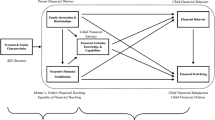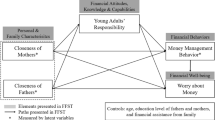Abstract
A qualitative study examined the perceptions of 22 Israeli young adults (ages 20–25) of childhood parental divorce. Respondents discussed their experiences, including economic consequences of the divorce. Results related to the practical aspect of economic decline, to economic issues as embodiment of parental conflicts, and to children’s emotional and practical roles connected to economic changes. Children’s understanding and coping with financial issues are related to three profiles of overall adjustment identified in this study—resilience, survival, and vulnerability. Resilient young adults interpreted as empowering their understanding and coping; the survivors recognized their efforts as meaningful but burdensome; and vulnerable participants felt that economic changes caused a heavy financial and emotional price. Limitations and implications are discussed.
Similar content being viewed by others
Notes
All names mentioned are assumed names, in order to ensure confidentiality.
For the sake of clarification, each name will be followed by designation of gender—young woman (f) or young man (m).
Since his parents were separated for many years, Uri described himself as a child of divorce; yet as they were not legally divorced and some issues were not settled, he is not part of the sample and his story was analyzed separately.
The size of each group is indicated as a reference, though, it being a qualitative in-depth study of a phenomenological nature, these numbers bear no statistical meaning.
References
Achdut, L., Cohen, R., & Endveld, M. (2006). Poverty rates and income gaps 2005: A report for the Israel National Insurance [in Hebrew]. Retrieved January 21, 2007, from http://www.btl.gov.il/NR/rdonlyres/4B3E27EB-E703-49B5-995D-BAF3938F445E/0/oni_2005.pdf
Amato, P. R. (1999). The postdivorce society: How divorce is shaping the family and other forms of social organization. In R. A. Thompson & P. R. Amato (Eds.), The postdivorce family: Children, parenting and society (pp. 161–190). Thousand Oaks: Sage.
Amato, P. R. (2000). The consequences of divorce for adults and children. Journal of Marriage and the Family, 62, 1269–1287.
Bianchi, S. M., & Spain, D. (1996). Women, work and family in America. Population Bulletin, 51(3), 2–49.
Bogdan, R., & Taylor, S. J. (1994). A positive approach to qualitative evaluation and policy research in social work. In E. Sherman & W. J. Reid (Eds.), Qualitative research in social work (pp. 293–302). New York: Columbia University Press.
Brown, C. (1994). The impact of divorce on families: The Australian experience. Family and Conciliation Courts Review, 32(2), 149–167.
Buchanan, C. M., Maccoby, E., & Dornbusch, S. M. (1996). Adolescents after divorce. Cambridge: Harvard University Press.
Central Bureau of Statistics of Israel. (2006a). [in Hebrew]. Retrieved January 21, 2007, from http://www1.cbs.gov.il/reader/newhodaot/hodaa_template.html?hodaa=200611041
Central Bureau of Statistics of Israel. (2006b). [in Hebrew]. Retrieved January 21, 2007, from http://www1.cbs.gov.il/reader/newhodaot/hodaa_template.html?hodaa=200611092
Cohen, O., Finzi, R., & Avi-Yonah, O. K. (1999). An attachment-based typology of divorcing couples. Family Therapy, 26, 167–190.
Coleman, M., & Ganong, L. H. (1992). Financial responsibility for children following divorce and remarriage. Journal of Family and Economic Issues, 13, 445–455.
Couch, K. A., & Lillard, D. R. (1997). Divorce, educational attainment and the earning mobility of sons. Journal of Family and Economic Issues, 18, 231–245.
Davis, F. (1991). Moving the mountain: The women’s movement in America since 1960. New York: Simon & Schuster.
Denzin, N. K. (1983). Interpretive interactions. In G. Morgan (Ed.), Beyond method: Strategies for social research (pp. 129–145). Beverly Hills: Sage.
Denzin, N. K. (1989). Interpretive interactionism. Newbury Park: Sage.
Eldar-Avidan, D. (2003). I would have been a totally different person.... Young adults whose parents divorced: Their perception of the implications of parental divorce on their lives. Unpublished doctoral dissertation, The Hebrew University of Jerusalem (In Hebrew).
Fogiel-Bijaoui, S. (1999). Families in Israel: Between family-orientation and post-modernism. In D. N. Izraeli, A. Friedman, H. Dahan-Kalev, S. Fogiel-Bijaoui, H. Herzog, M. Hasan, & H. Naveh (Eds.), Sex, gender, politics: Women in Israel [in Hebrew]. Tel Aviv: Hakibbutz Hameuchad.
Forste, R., & Heaton, T. B. (2004). The divorce generation: Well-being, family attitudes and socioeconomic consequences of marital disruption. Journal of Divorce & Remarriage, 41(1–2), 95–114.
Grych, J. H., & Fincham, F. D. (1999). The adjustment of children from divorced families: Implications of empirical research for intervention. In R. M. Galatzer-Levy & L. Kraus (Eds.), The scientific basis of child custody decisions (pp. 96–119). New York: John Wiley.
Hammersley, M. (1992). What’s wrong with ethnography? Methodological explorations. London: Routledge.
Hetherington, E. M., Bridges, M., & Insabella, G. (1998). What matters, what doesn’t: Five perspectives on the association between divorce and remarriage and children’s adjustment. American Psychologist, 53, 167–183.
Hetherington, E. M., & Kelly, J. (2002). For better or for worse: Divorce reconsidered. New York: W. W. Norton.
Hilton, J. M., & Kopera-Frye, K. (2004). Problems of psychological adjustment among divorce custodial parents. Journal of Divorce and Remarriage, 41(3/4), 1–30.
Johnston, J. R., & Roseby, V. (1997). In the name of the child: A developmental approach to understanding and helping children of conflicted and violent divorce. New York: Free Press.
Josselson, R. (1995). Imagining the real: Empathy, narrative, and the dialogic self. In R. Josselson & A. Lieblich (Eds.), Interpreting experience: The narrative study of lives, Vol. 3 (pp. 27–44). Thousand Oaks: Sage.
Kruk, E. (1993). Promoting co-operative parenting after separation: A therapeutic/interventionist model of family mediation. Journal of Family Therapy, 15, 235–261.
Kvale, S. (1996). InterViews. Thousand Oaks: Sage.
Leary, M. R. (1995). Self presentation: Impression management and interpersonal behavior. Madison: Brown & Benchmark.
Lechman, S. J., & Koerner, S. S. (2002). Family financial hardship and adolescent girls’ adjustment: The role of maternal disclosure of financial concerns. Journal of Developmental Psychology, 48, 1–24.
Lieblich, A., Tuval-Mashiach, R., & Zilber, T. (1998). Narrative research: Reading, analysis, and interpretation. Thousand Oaks: Sage.
Lindlof, T. R. (1995). Qualitative communication research methods. Thousand Oaks: Sage.
Lowenstein, L. F. (2005). Causes and associated features of divorce as seen by recent research. Journal of Divorce and Remarriage, 42(3/4), 153–171.
Marshal, C., & Rossman, G. B. (1989). Designing qualitative research. Newbury Park: Sage.
Mason, J. (1996). Qualitative research. London: Sage.
Mauldin, T. A., & Mimura, Y. (2007). Marrying, unmarrying, and poverty dynamics among mothers with children living at home. Journal of Family and Economic Issues, 28(4), 566–582.
Miles, M. B., & Huberman, A. M. (1994). Qualitative data analysis (2nd Ed.). Thousand Oaks: Sage.
Morgan, L. A., Kitson, G. C., & Kitson, J. T. (1992). The economic fallout from divorce: Issues for the 1990’s. Journal of Family and Economic Issues, 13, 435–443.
Morrison, D. R., & Ritualno, A. (2000). Routes to children’s economic recovery after divorce: Are cohabitation and remarriage equivalent? American Sociological Review, 65, 560–580.
Padgett, D. K. (1998). Qualitative methods in social work research: Challenges and rewards. Thousand Oaks: Sage.
Pam, A., & Pearson, J. (1998). Splitting up: Enmeshment and estrangement in the process of divorce. New York: The Guilford Press.
Radina, M. E. (2003). Daughters of childhood parental divorce and their relationship with their fathers in adulthood: Four typologies. Journal of Divorce and Remarriage, 33(3/4), 61–82.
Rubin, A. (2000). Standards for rigor in qualitative inquiry. Research on Social Work Practice, 10, 173–178.
Schramm, D. G. (2006). Individual and social costs of divorce in Utah. Journal of Family and Economic Issues, 27, 133–151.
Smart, C., & Neale, B. (1999). Family fragments. Cambridge: Polity Press.
Smart, C., Neale, B., & Wade, A. (2001). The changing experience of childhood: Families and divorce. Cambridge: Polity Press.
Strauss, A., & Corbin, J. (1994). Grounded theory methodology: An overview. In N. K. Denzin & Y. S. Lincoln (Eds.), Handbook of qualitative research (pp. 273–285). Thousand Oaks: Sage.
Taylor, S. J., & Bogdan, R. (1998). Introduction to qualitative research methods: A guidebook and resource (3rd Ed.). New York: John Wiley.
Wallerstein, J. S., & Corbin, S. B. (1999). The child and the vicissitudes of divorce. In R. M. Galatzer-Levy & L. Kraus (Eds.), The scientific basis of child custody decisions (pp. 73–95). New York: John Wiley.
Wallerstein, J. S., & Kelly, J. B. (1980). Surviving the breakup: How children and parents cope with divorce. New York: Basic Books.
Wang, H., & Amato, P. R. (2000). Predictors of divorce adjustment: Stressors, resources, and definitions. Journal of Marriage and the Family, 62, 655–668.
Whiteside, M. F. (1998). The parental alliance following divorce: An overview. Journal of Marital and Family Therapy, 24, 3–24.
Young, I. M. (1997). Interesting voices. Princeton: Princeton University Press.
Acknowledgements
This paper is based on some of the results presented in Dr. Dorit Eldar-Avidan’s Ph.D. dissertation project. The study was partially funded by the Miriam Pelton Fund, the Henry Zucker Fund, the Martin and Vivian Levin Center for the Normal and Psychopathological Development of the Child and Adolescent (Hebrew University of Jerusalem) and by a scholarship from the Ministry of Social Affairs in Israel.
Author information
Authors and Affiliations
Corresponding author
Rights and permissions
About this article
Cite this article
Eldar-Avidan, D., Haj-Yahia, M.M. & Greenbaum, C.W. Money Matters: Young Adults’ Perception of the Economic Consequences of their Parents’ Divorce. J Fam Econ Iss 29, 74–85 (2008). https://doi.org/10.1007/s10834-007-9093-4
Published:
Issue Date:
DOI: https://doi.org/10.1007/s10834-007-9093-4




